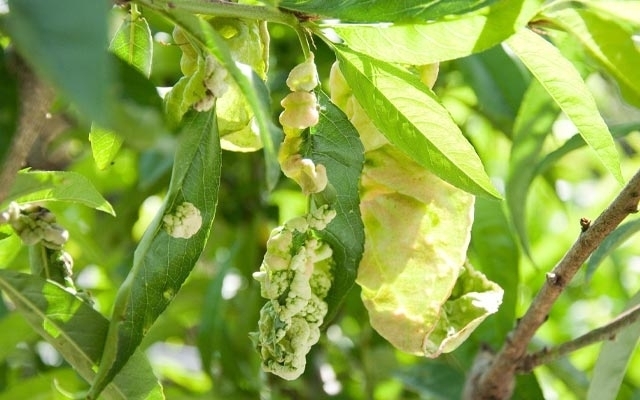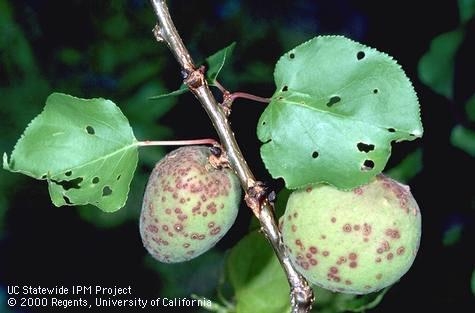If you have a fruit tree, you know that gardeners are not the only ones who enjoy the bounty of the harvest. There are many pests — such as scales, aphids and mites –that feast on the tender plant parts and these same pests overwinter on the fruit trees. Dormant oils help control these annoying pests and are safe for use on fruit trees.
Dormant sprays or delayed dormant sprays are a generic term for an application of pesticides—including fungicides, highly refined horticultural oils and oils in combination with a pesticide– that are applied to leafless deciduous trees during fall, winter, and early spring. All fruit and nut trees and many landscape trees and roses are susceptible to aphids, mites, scale and specific insect and disease problems affecting fruit quality and tree health
Some dormant sprays are applied to control over-wintering insects, while others are used to prevent disease infection. While dormant sprays are commonly used on fruit trees, they can also benefit roses and other ornamental shrubs that might develop insect or fungal disease problems as the warmer weather arrives in the spring. Dormant sprays should only be used in conjunction with good garden sanitation. Be sure to rake up and dispose of all fallen leaves and debris that may harbor fungus spores and overwintering insects.
Dormant oil is a refined petroleum product formulated for fruit tree use. It has been in use for well over a century in commercial orchards, and is still regularly used today. It is classified as an insecticide, and acts by coating over-wintering insects hiding in tree trunk and limb bark with a suffocating layer of oil. Oils used at this time of year include insecticidal oils, narrow range, supreme and superior oils. Dormant disease control applications use materials such as copper, lime sulfur, Bordeaux, and synthetic fungicides.
Dormant sprays provide efficient and economical treatment for a number of over-wintering pests and diseases such as: scale, peach twig borer, aphid eggs, leaf curl, powdery mildew and shot hole.
Here is a partial list for fruit trees:
• Apple and pear – dormant oil helps control scale, overwintering aphids, mite eggs and pear phyla.
• Apricot – dormant oil helps control scale, mite and aphid eggs and peach tree borer. Never use sulfur on apricots.
• Cherry – is susceptible to oozing from gummosis (Bacterial canker) and may respond to dormant sprays containing fixed copper.
• Peach and nectarine – require repeated applications of fixed copper spray to control peach leaf curl. In December or January, prune off half to two thirds of last season's growth to stimulate new fruiting wood. Spray the ground after removing leaves and branches. Use dormant oil if scale is present.
• Plum and prune -dormant oil helps control scale and overwintering aphid and mite eggs. Apply copper for shot hole fungus. Heavy pruning may be needed to help control tree size. Spray ground after clean up.
• Nut trees- remove any nuts still hanging on the tree. Spray with dormant oil to control scale. Oil sprays also help control peach tree borers and mite eggs.
Applying dormant or delayed dormant treatments
A dormant spray may not be required every year in the backyard orchard. For some insect pests and diseases, one dormant application may be adequate with good spray coverage. For other problems, up to 3 applications may be necessary for good control. Decide if you need to apply by noting the amount of insect and disease pressure during the previous growing season. If you decide to spray always read the label and follow the directions, more is not better. Make sure you dress in protective clothing, including long pants, a long-sleeved shirt, chemical-proof gloves, and safety goggles.
Treat at the beginning of dormancy in late November and again just before the buds begin to open in February or early March. One way to remember when to consider dormant spraying is to do so around Thanksgiving, Christmas and Valentine's Day. Once flower buds begin to open you may damage fruit and kill pollinating bees if spraying is done at this time. Therefore, it is important to spray at the proposed times before “bud break”. Spraying after pruning allows maximum coverage since there are no leaves to block the spray. A good time to spray is right after a period of rain or foggy weather but not during fog, rain or right before a freeze. Avoid spraying trees that are showing signs of drought stress.
Sprays can be applied with a pump sprayer or hose-end sprayer that is sized appropriately for the number of plants you need to spray. The sprayer should be clean, in good working order and not been used for any herbicides. Spray the entire dormant plant taking care to saturate every branch, stem or cane as insects and the tiny dust-like spores of fungal diseases hide in the smallest nooks and crevices. Don't use a dormant spray on any plant that has any leaves or is actively growing. Leaves, especially tender new growth, may be damaged by the spray from the impurities in the oils or the reflection of the sun off the oil.
Dormant oils generally won't harm beneficial insects since they are applied at a time when beneficial insects aren't present on fruit trees and have a low toxicity level to humans and mammals. Furthermore, dormant oils won't leave harsh residue behind. It loses its ability to control pests once dried.
If you have a gardening related question you can contact the UC Master Gardeners at 209-953-6112. More information can be found on our website: ucanr.edu/sjmg